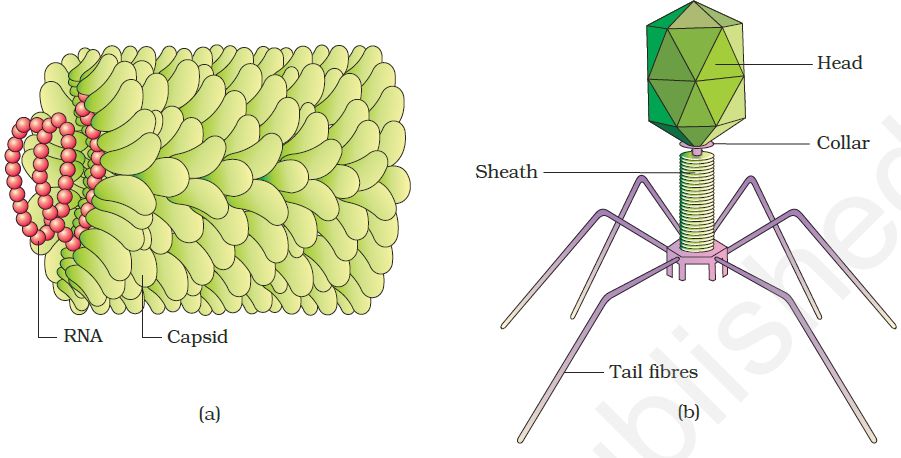


 النبات
النبات
 الحيوان
الحيوان
 الأحياء المجهرية
الأحياء المجهرية
 علم الأمراض
علم الأمراض
 التقانة الإحيائية
التقانة الإحيائية
 التقنية الحيوية المكروبية
التقنية الحيوية المكروبية
 التقنية الحياتية النانوية
التقنية الحياتية النانوية
 علم الأجنة
علم الأجنة
 الأحياء الجزيئي
الأحياء الجزيئي
 علم وظائف الأعضاء
علم وظائف الأعضاء
 الغدد
الغدد
 المضادات الحيوية
المضادات الحيوية|
Read More
Date: 21-10-2015
Date: 26-10-2015
Date: 14-10-2015
|
Viruses, Viroids and Lichens
In the five Kingdom classification of Whittaker there is no mention of some acellular organisms like viruses and viroids, and lichens. These are briefly introduced here.
All of us who have suffered the ill effects of common cold or ‘flu’ know what effects viruses can have on us, even if we do not associate it with our condition. Viruses did not find a place in classification since they are not truly ‘living’, if we understand living as those organisms that have a cell structure. The viruses are non-cellular organisms that are characterised by having an inert crystalline structure outside the living cell. Once they infect a cell they take over the machinery of the host cell to replicate themselves, killing the host. Would you call viruses living or non-living?
The name virus that means venom or poisonous fluid was given by Pasteur. D.J. Ivanowsky (1892) recognised certain microbes as causal organism of the mosaic disease of tobacco (Figure a). These were found to be smaller than bacteria because they passed through bacteria-proof filters. M.W. Beijerinek (1898) demonstrated that the extract of the infected plants of tobacco could cause infection in healthy plants and called the fluid as Contagium vivum fluidum (infectious living fluid). W.M. Stanley (1935) showed that viruses could be crystallised and crystals consist largely of proteins. They are inert outside their specific host cell. Viruses are obligate parasites.
In addition to proteins, viruses also contain genetic material, that could be either RNA or DNA. No virus contains both RNA and DNA. A virus is a nucleoprotein and the genetic material is infectious. In general, viruses that infect plants have single stranded RNA and viruses that infect animals have either single or double stranded RNA or double stranded DNA.
Bacterial viruses or bacteriophages (viruses that infect the bacteria) are usually double stranded DNA viruses (Figure b). The protein coat called capsid made of small subunits called capsomeres, protects the nucleic acid. These capsomeres are arranged in helical or polyhedral geometric forms. Viruses cause diseases like mumps, small pox, herpes and influenza. AIDS in humans is also caused by a virus. In plants, the symptoms can be mosaic formation, leaf rolling and curling, yellowing and vein clearing, dwarfing and stunted growth.
Viroids : In 1971, T.O. Diener discovered a new infectious agent that was smaller than viruses and caused potato spindle tuber disease. It was found to be a free RNA; it lacked the protein coat that is found in viruses, hence the name viroid. The RNA of the viroid was of low molecular weight.
Lichens : Lichens are symbiotic associations i.e. mutually useful associations, between algae and fungi. The algal component is known as phycobiont and fungal component as mycobiont, which are autotrophic and heterotrophic, respectively. Algae prepare food for fungi and fungi provide shelter and absorb mineral nutrients and water for its partner.
So close is their association that if one saw a lichen in nature one would never imagine that they had two different organisms within them. Lichens are very good pollution indicators – they do not grow in polluted areas.
 Figure . (a) Tobacco Mosaic Virus (TMV) (b) Bacteriophage.
Figure . (a) Tobacco Mosaic Virus (TMV) (b) Bacteriophage.



|
|
|
|
علامات بسيطة في جسدك قد تنذر بمرض "قاتل"
|
|
|
|
|
|
|
أول صور ثلاثية الأبعاد للغدة الزعترية البشرية
|
|
|
|
|
|
|
مكتبة أمّ البنين النسويّة تصدر العدد 212 من مجلّة رياض الزهراء (عليها السلام)
|
|
|